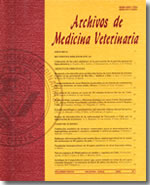Glutathion peroxidase activity (GSH-Px) in grazing dairy cattle in the south of Chile (IXth Region) and their relation with selenium contents in the forage
Main Article Content
Abstract
The content of selenium (Se) in forage samples and the blood activity of glutathione peroxidase (GSH-Px; EC 1.11.1.9) of groups of lactating cows and heifers were evaluated between autumn and spring of 1999 in 12 dairy herds from IXth Region (38º S and 71º W) of Chile. Se-concentration was determined in forage samples by using inductively coupled plasma mass spectroscopy (ICP-MS). The activity of GSH-Px was determined through a kinetic technique NADPH-dependant. Mean, standard deviation and range were obtained, and the groups were compared by ANOVA test and the values compared to reference values. The content of Se in forage samples was 0.03±0.02 ppm, the range was between < 0.01 to 0.08 ppm. 83% of the samples had a Se-concentration below the minimum dietary requirements (<0.05 ppm) for grazing cattle. Blood activity of GSH-Px was 129±112 U/g Hb, and the range was 34-545 U/g Hb. There was not difference between autumn and spring (p>0.05). Heifers showed a lower activity for GSH-Px than cows in both periods (p<0.05). Twenty percent of the animals showed a low activity of GSH-Px (below 60 U/g Hb), meaning a Se deficiency in the animals. There was a relation between the content of Se in forage and the blood activity of GSH-Px in heifers (r= 0.74; p<0.05).
Accordingly, the content of Se in most of the forage produced in the dairy cattle area from the IXth Region, Chile is below the nutritional requirements for grazing dairy cattle and nutritional metabolic deficiencies of Se are present in dairy herds according to blood activity of GSH-Px. Heifers are mostly affected.

